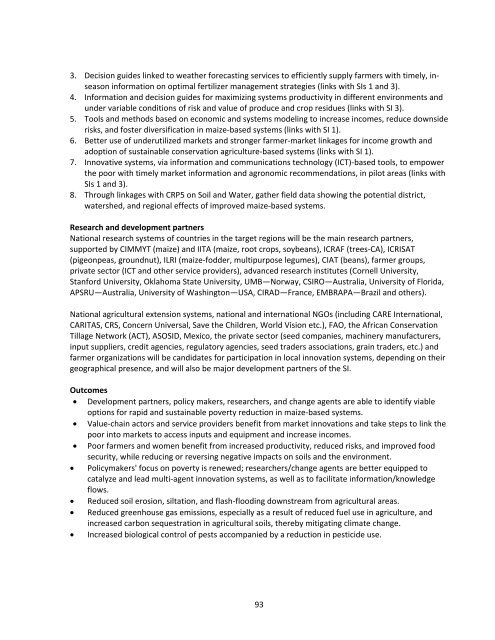Download - Maize
Download - Maize
Download - Maize
You also want an ePaper? Increase the reach of your titles
YUMPU automatically turns print PDFs into web optimized ePapers that Google loves.
3. Decision guides linked to weather forecasting services to efficiently supply farmers with timely, inseason<br />
information on optimal fertilizer management strategies (links with SIs 1 and 3).<br />
4. Information and decision guides for maximizing systems productivity in different environments and<br />
under variable conditions of risk and value of produce and crop residues (links with SI 3).<br />
5. Tools and methods based on economic and systems modeling to increase incomes, reduce downside<br />
risks, and foster diversification in maize‐based systems (links with SI 1).<br />
6. Better use of underutilized markets and stronger farmer‐market linkages for income growth and<br />
adoption of sustainable conservation agriculture‐based systems (links with SI 1).<br />
7. Innovative systems, via information and communications technology (ICT)‐based tools, to empower<br />
the poor with timely market information and agronomic recommendations, in pilot areas (links with<br />
SIs 1 and 3).<br />
8. Through linkages with CRP5 on Soil and Water, gather field data showing the potential district,<br />
watershed, and regional effects of improved maize‐based systems.<br />
Research and development partners<br />
National research systems of countries in the target regions will be the main research partners,<br />
supported by CIMMYT (maize) and IITA (maize, root crops, soybeans), ICRAF (trees‐CA), ICRISAT<br />
(pigeonpeas, groundnut), ILRI (maize‐fodder, multipurpose legumes), CIAT (beans), farmer groups,<br />
private sector (ICT and other service providers), advanced research institutes (Cornell University,<br />
Stanford University, Oklahoma State University, UMB—Norway, CSIRO—Australia, University of Florida,<br />
APSRU—Australia, University of Washington—USA, CIRAD—France, EMBRAPA—Brazil and others).<br />
National agricultural extension systems, national and international NGOs (including CARE International,<br />
CARITAS, CRS, Concern Universal, Save the Children, World Vision etc.), FAO, the African Conservation<br />
Tillage Network (ACT), ASOSID, Mexico, the private sector (seed companies, machinery manufacturers,<br />
input suppliers, credit agencies, regulatory agencies, seed traders associations, grain traders, etc.) and<br />
farmer organizations will be candidates for participation in local innovation systems, depending on their<br />
geographical presence, and will also be major development partners of the SI.<br />
Outcomes<br />
Development partners, policy makers, researchers, and change agents are able to identify viable<br />
options for rapid and sustainable poverty reduction in maize‐based systems.<br />
Value‐chain actors and service providers benefit from market innovations and take steps to link the<br />
poor into markets to access inputs and equipment and increase incomes.<br />
Poor farmers and women benefit from increased productivity, reduced risks, and improved food<br />
security, while reducing or reversing negative impacts on soils and the environment.<br />
Policymakers' focus on poverty is renewed; researchers/change agents are better equipped to<br />
catalyze and lead multi‐agent innovation systems, as well as to facilitate information/knowledge<br />
flows.<br />
Reduced soil erosion, siltation, and flash‐flooding downstream from agricultural areas.<br />
Reduced greenhouse gas emissions, especially as a result of reduced fuel use in agriculture, and<br />
increased carbon sequestration in agricultural soils, thereby mitigating climate change.<br />
Increased biological control of pests accompanied by a reduction in pesticide use.<br />
93

















